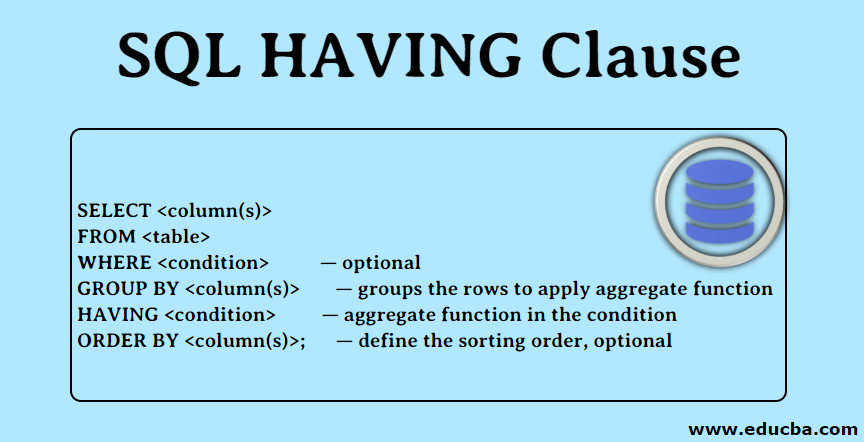#sqlhavingclause 搜尋結果
Day 17 of #20dayswithdata Treating Null values Day 18 of #20dayswithdata Having clause #SQLHavingClause #DataAggregation #NULLValues #DataCleaning #MySQL
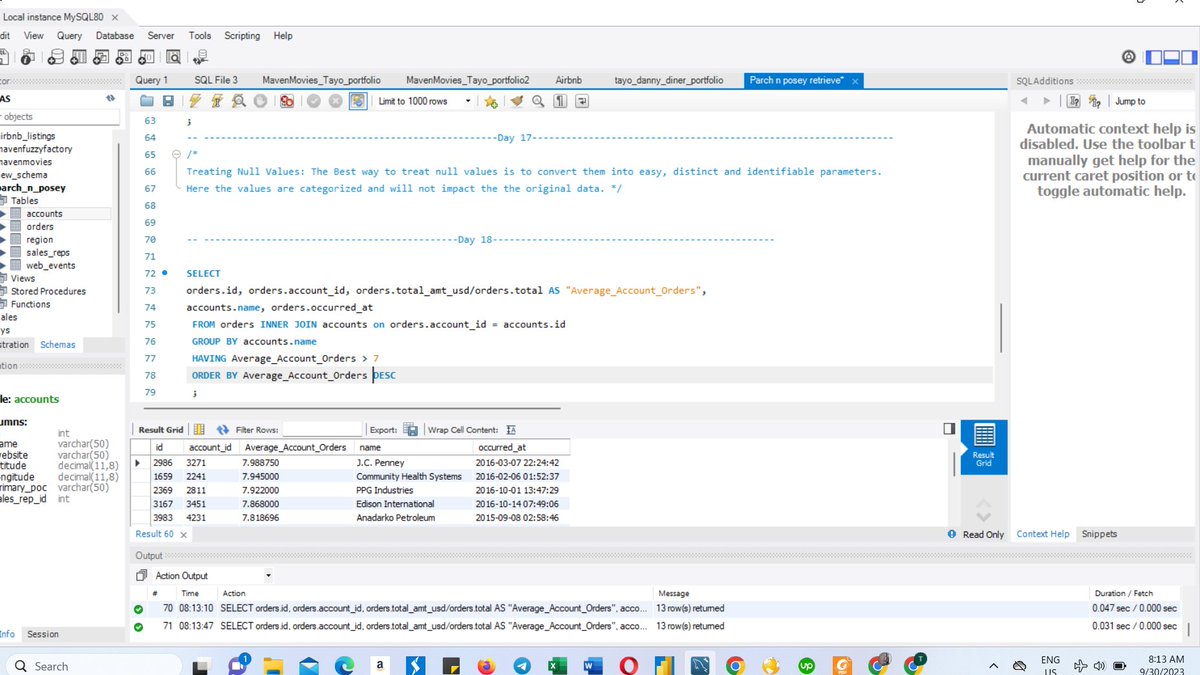
Day 18 of #20dayswithdata. The snapshot below shows a list of customers with an average order value above the threshold (overall average order), which implies a good purchasing ability required for business to flourish. #SQLHavingClause #DataAggregation

Day 18 Calculate the average order value for each customer and filter with an average above a certain amount. I wrote a query that found customers with an average order value that is above the overall average order which is $6.30. #20dayswithdata #SQLHavingClause
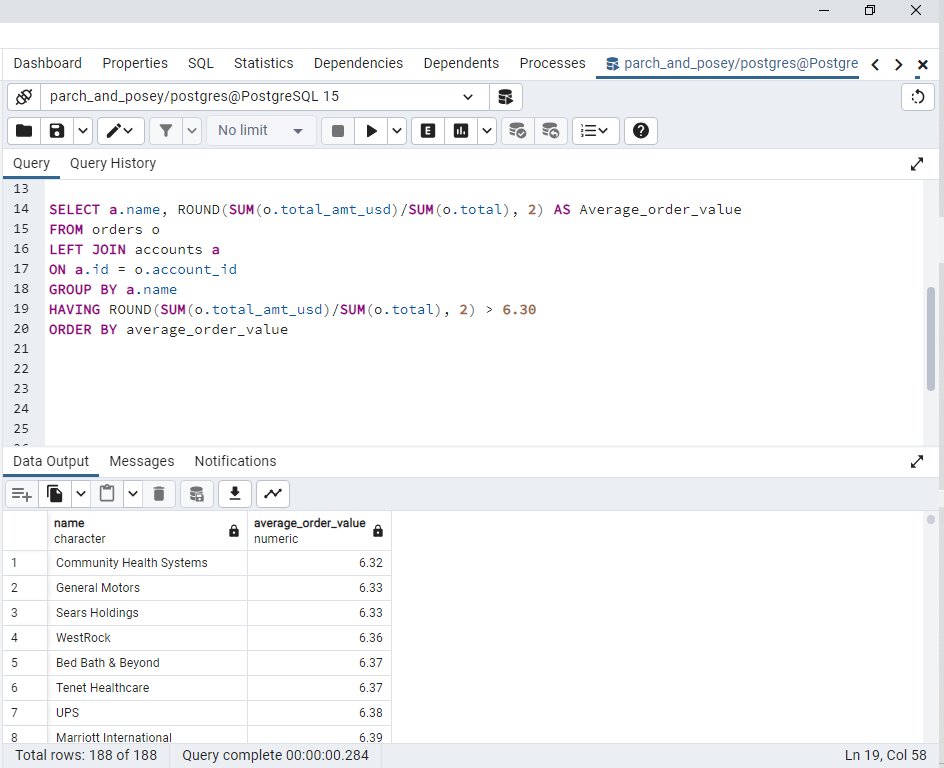
DAY 18: AGGREGTING WITH HAVING I used the having clause in an SQL query to calculate the average order value for each customer and filtered them with an average above five. #20dayswithdata #SQLHAVINGCLAUSE #DataAggregation
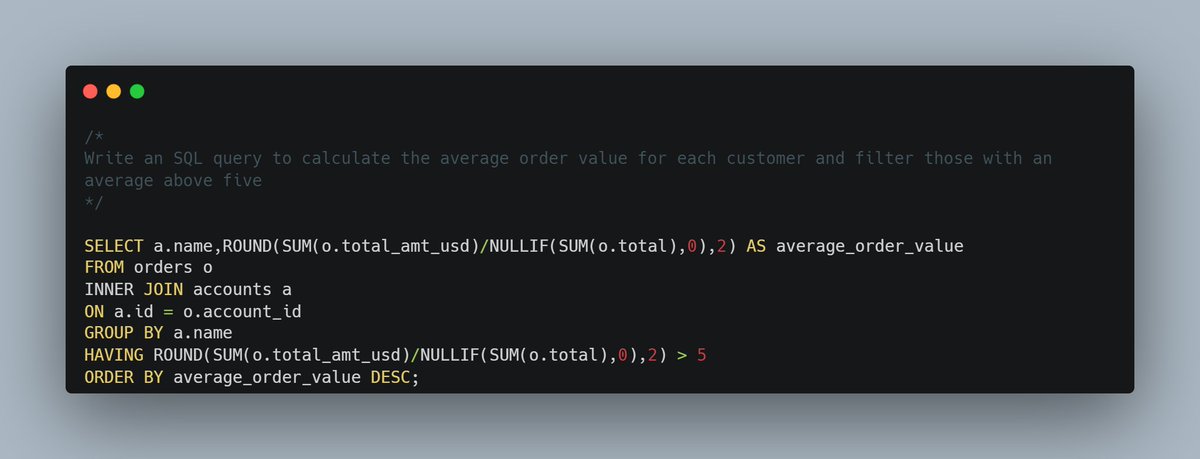
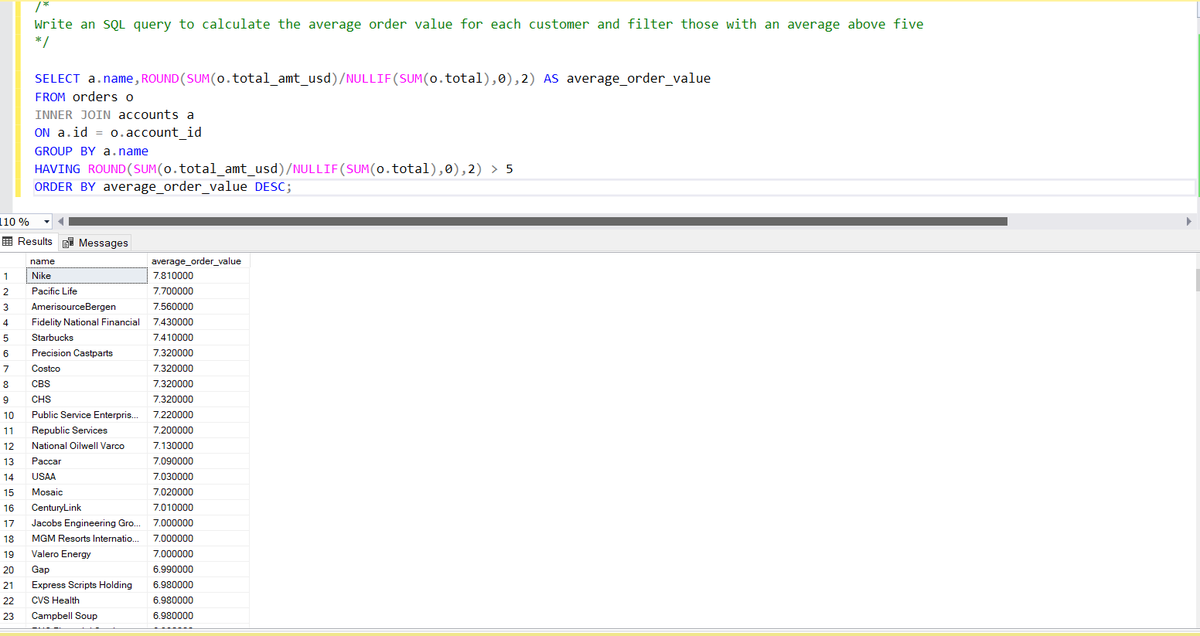
Day 18: Aggregating with HAVING Which customers have an average order value greater than the overall average order value? Any customer with an order value above average can be classified as a a big spender. #20dayswithdata #SQLHavingClause #DataAggregation
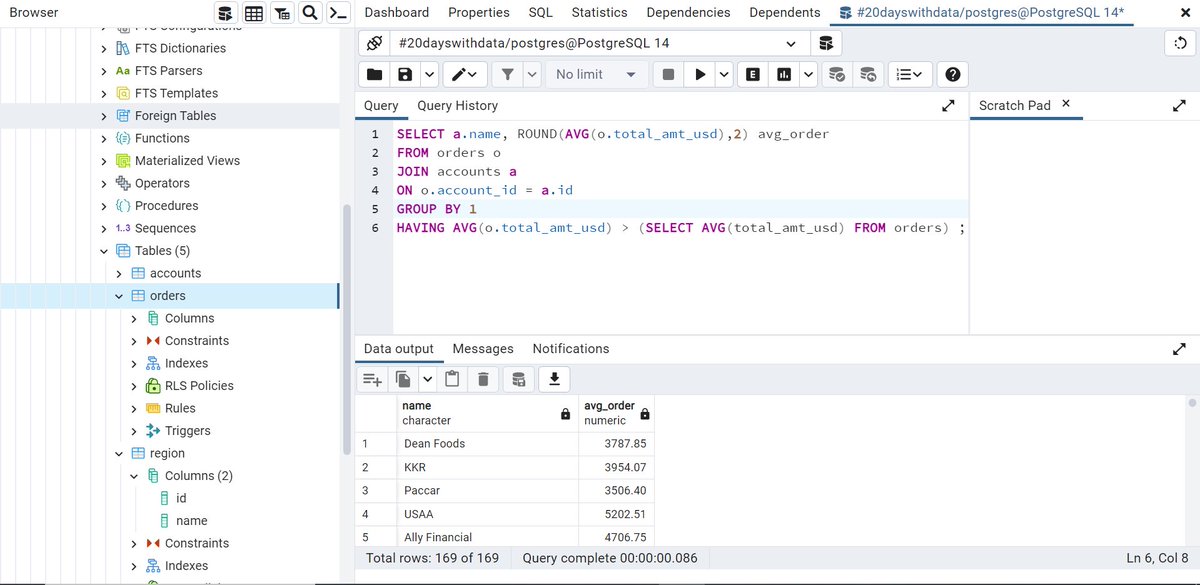
Day 18: Aggregating with Having Calculated the Average order value for each customer,using the Having clause to filter those with average order greater than 6.30 which is the Overall average order value. #SQLHavingclause #20dayswithdata #hertechtrailacademy @ImaNjokko @fresh_gb
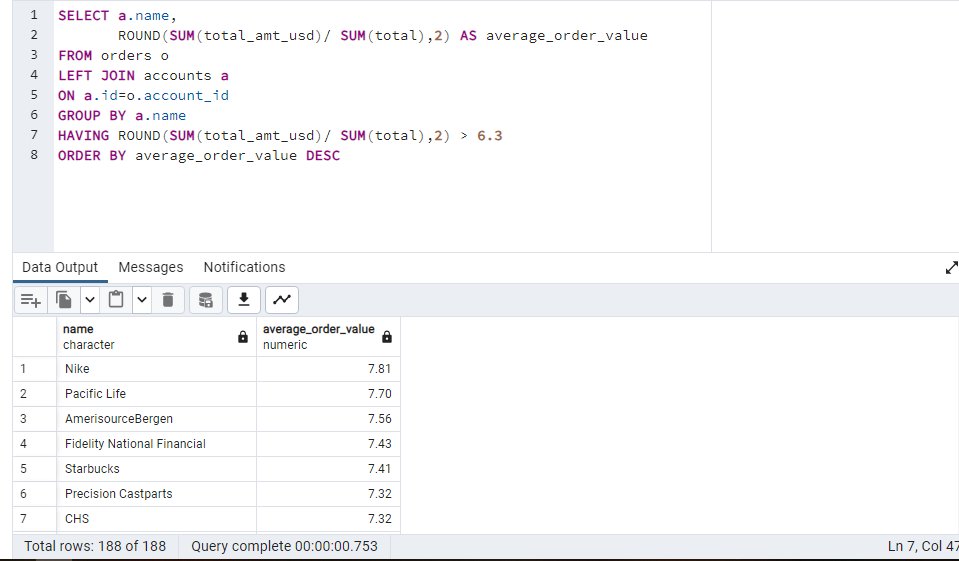
Day 18 #20dayswithdata Wrote an SQL query to calculate the average order value for each customer and filter those with an average above a certain amount. #SQLHavingClause #DataAggregation.
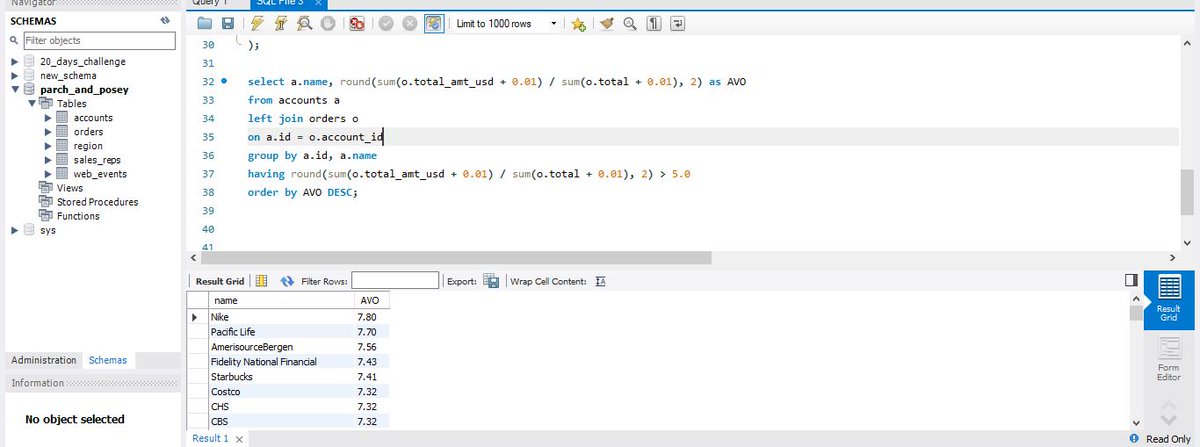
Day 18 #20Dayswithdata An SQL query to calculate the average order value for each customer and filter those with an average above a certain amount. #SQLHavingClause #DataAggregation
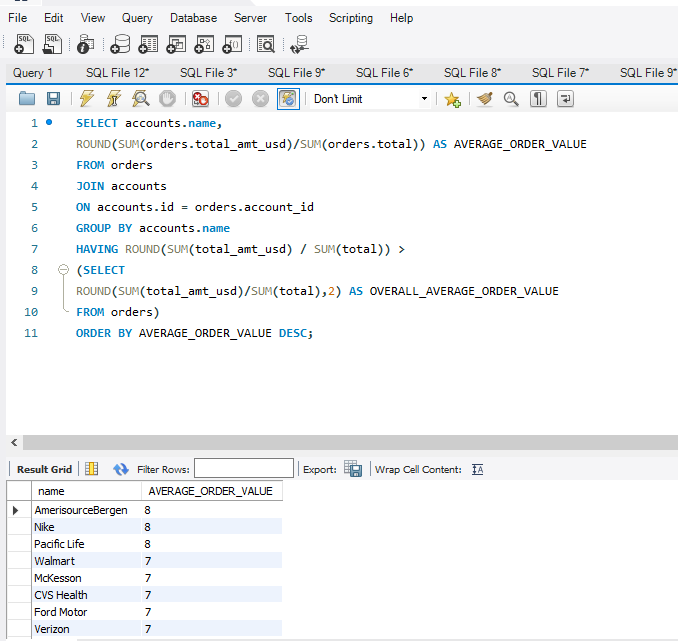
Day 18. I generated the list of companies that have an average order rate above the overall average order rate. This highlights the companies that have a better purchasing ability, compared to their counterparts. #20dayswithdata #SQLHavingClause #DataAggregation
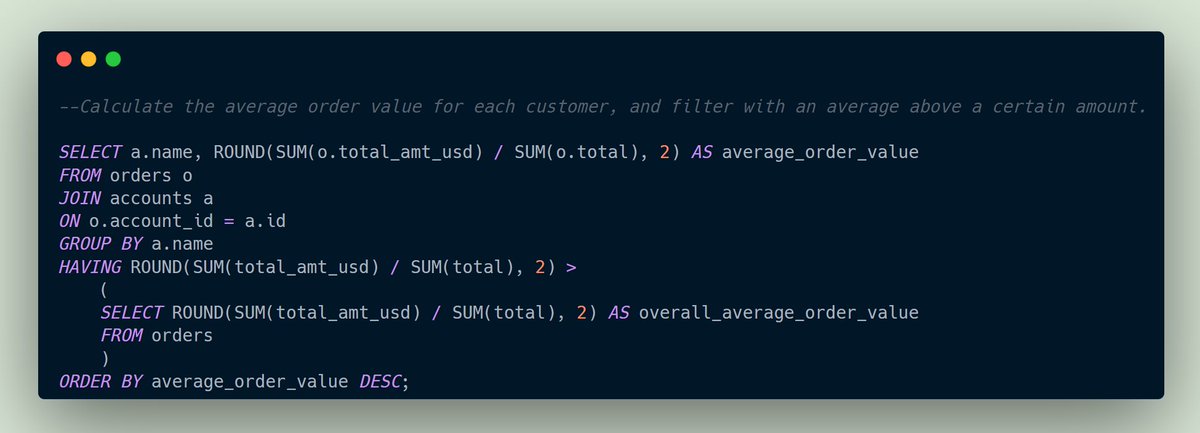
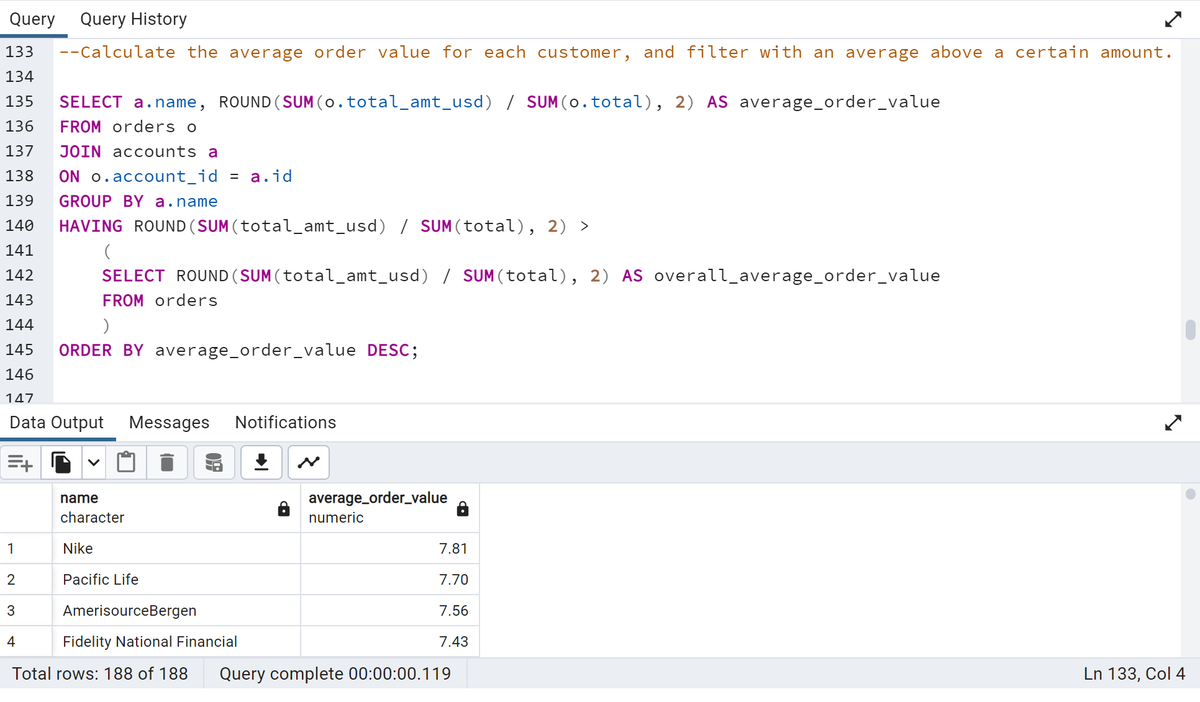
DAY 18; I calculated the average order of each customer and i filtered using an average order greater than 6.5 #Hertechtrail #SQLHavingClause #DataAggregation. @ImaNjokko
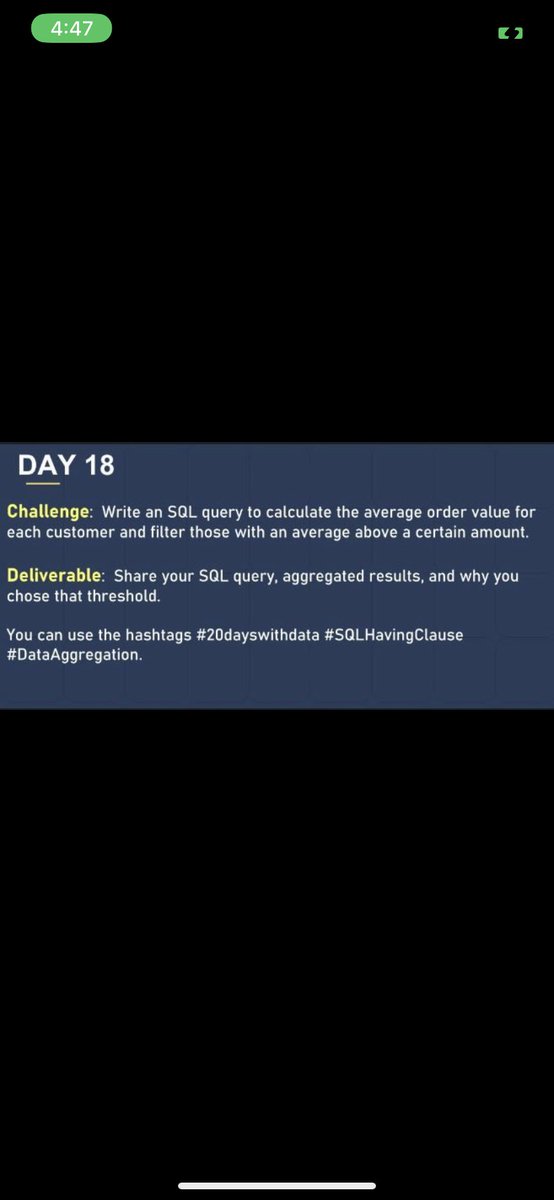
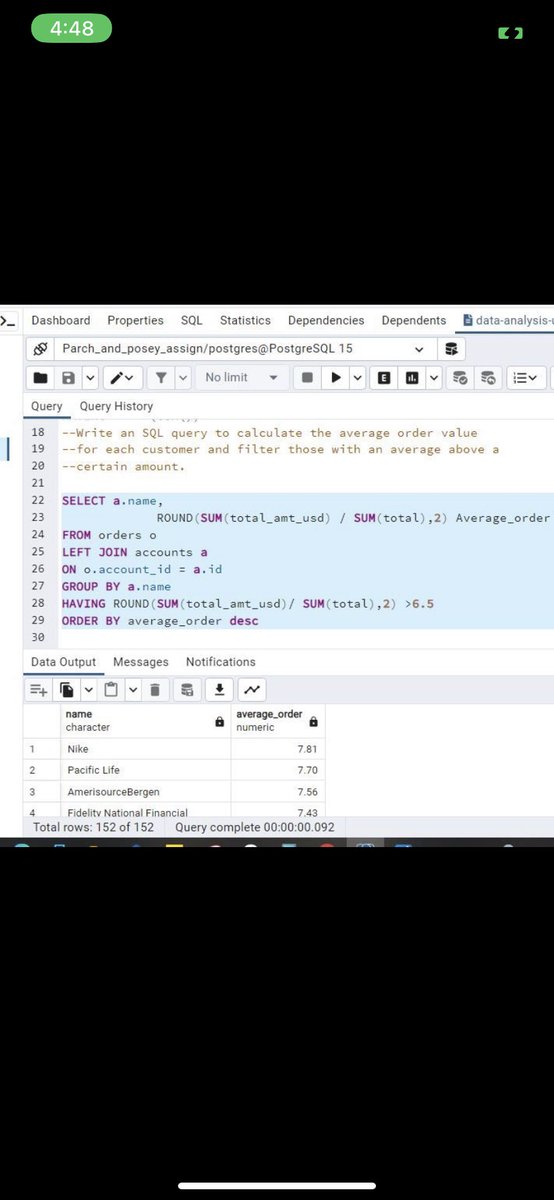
Day 18 of #20days with data I generated the list of companies that have an average order rate above the overall average order rate. #20dayswithdata #SQLHavingClause #DataAggregation#20dayswithdata

Day 18: Aggregating with HAVING 20 Days With Data Challenge I Wrote an SQL query to calculate the average order value for each customer and filter those with an average above a certain amount. #20dayswithdata #SQLHavingClause #DataAggregation.
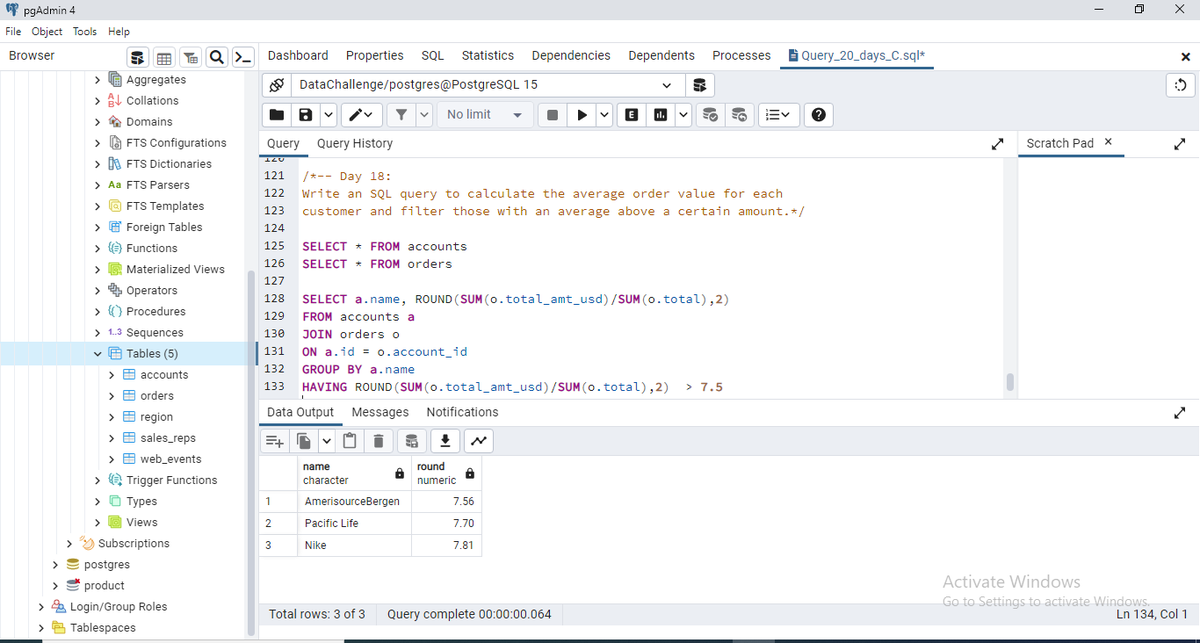
Day 18. Today we focus on aggregation and filtration using the 'HAVING' clause. Lets goooo!!!!! You can use the hashtags #20dayswithdata #SQLHavingClause #DataAggregation
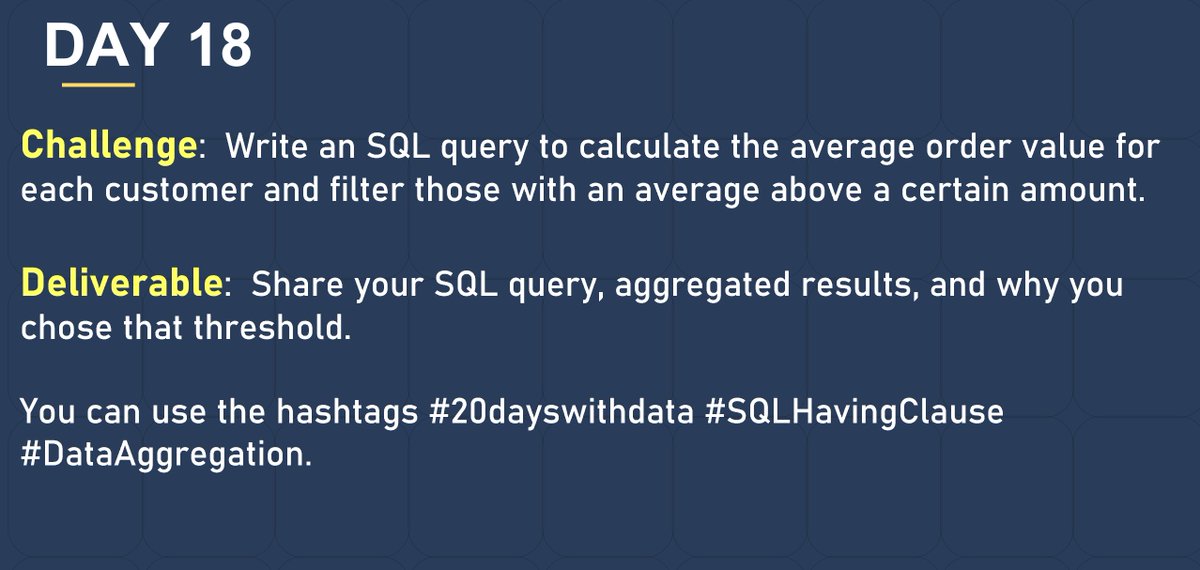
Day 18 We are focusing on aggregation and I decided to look at the average amount spent by each customer and specifically customers who average amount are greater than the overall average amount using the 'HAVING' clause. #20dayswithdata #SQLHavingClause #DataAggregation
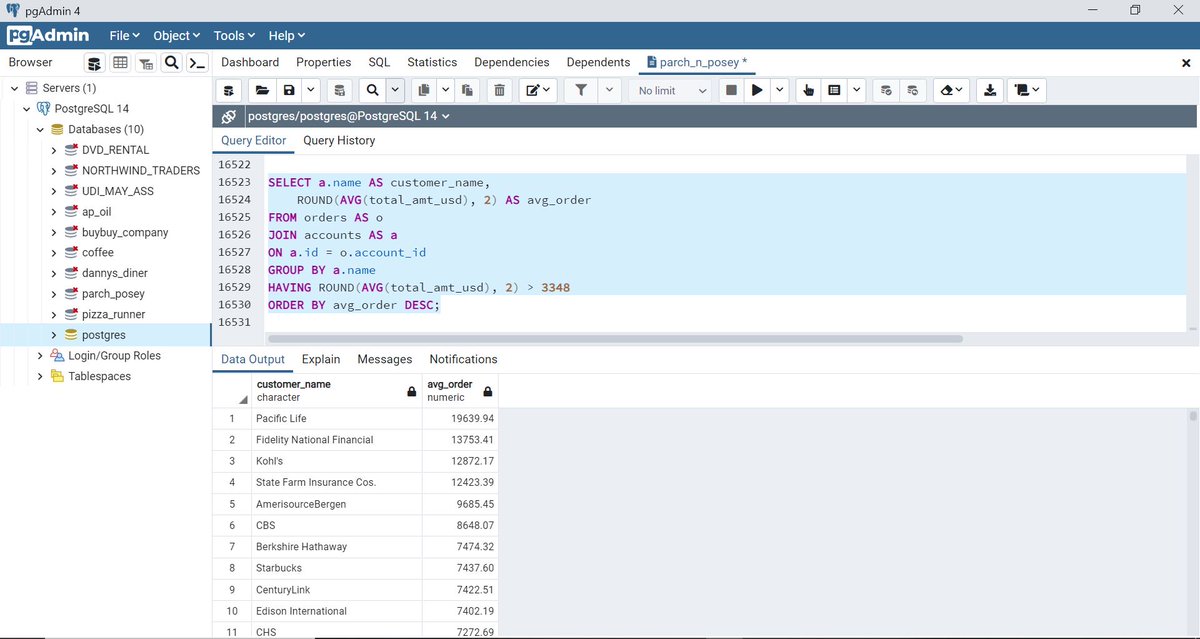
Day 17 How to handle null values Typically, a null value is an unknown or missing value in a dataset. There are various ways to handle this but first thing is to go through your data, table by table to know the data types present. From here, we can know how many values are
helping us identify high-value customers and potential areas for revenue growth. #hertechtrailacademy #SQLhavingclause #SQLaggregation #buildinpublic @ @phaibooboo @fresh_gb @FrizzyHub @zulaykha_o
to keep them and maximize revenue. #SQLHavingClause #DataAggregation #hertechtrailacademy #dataanalytics @phaibooboo @fresh_gb
overall average value, by using the HAVING clause to filter the query since I am working with aggregated values. #hertechtrailacademy #HTTDataChallenge @hertechtrail @phaibooboo , @ImaNjokko , @fresh_gb , @vicSomadina ,@AtiJoshua , @OMOTOSHOOLAMI15 #SQLHavingClause #DataAggregat
-They are more likely to be devoted to the business, and this deserves to be appreciated and rewarded. #hertechtrailacademy #HTTDataChallenge #SQLHavingClause #DataAggregation. @hertechtrail, @phaibooboo , @ImaNjokko , @fresh_gb , @vicSomadina , @AtiJoshua , @OMOTOSHOOLAMI15
Day 18 Calculate the average order value for each customer and filter with an average above a certain amount. I wrote a query that found customers with an average order value that is above the overall average order which is $6.30. #20dayswithdata #SQLHavingClause

Day 18: Aggregating with HAVING Which customers have an average order value greater than the overall average order value? Any customer with an order value above average can be classified as a a big spender. #20dayswithdata #SQLHavingClause #DataAggregation

Day 17 of #20dayswithdata Treating Null values Day 18 of #20dayswithdata Having clause #SQLHavingClause #DataAggregation #NULLValues #DataCleaning #MySQL

Day 18 #20Dayswithdata An SQL query to calculate the average order value for each customer and filter those with an average above a certain amount. #SQLHavingClause #DataAggregation

Day 18 of #20dayswithdata. The snapshot below shows a list of customers with an average order value above the threshold (overall average order), which implies a good purchasing ability required for business to flourish. #SQLHavingClause #DataAggregation

Day 18: Aggregating with HAVING 20 Days With Data Challenge I Wrote an SQL query to calculate the average order value for each customer and filter those with an average above a certain amount. #20dayswithdata #SQLHavingClause #DataAggregation.

overall average value, by using the HAVING clause to filter the query since I am working with aggregated values. #hertechtrailacademy #HTTDataChallenge @hertechtrail @phaibooboo , @ImaNjokko , @fresh_gb , @vicSomadina ,@AtiJoshua , @OMOTOSHOOLAMI15 #SQLHavingClause #DataAggregat
Day 18: Aggregating with Having Calculated the Average order value for each customer,using the Having clause to filter those with average order greater than 6.30 which is the Overall average order value. #SQLHavingclause #20dayswithdata #hertechtrailacademy @ImaNjokko @fresh_gb

DAY 18; I calculated the average order of each customer and i filtered using an average order greater than 6.5 #Hertechtrail #SQLHavingClause #DataAggregation. @ImaNjokko


DAY 18: AGGREGTING WITH HAVING I used the having clause in an SQL query to calculate the average order value for each customer and filtered them with an average above five. #20dayswithdata #SQLHAVINGCLAUSE #DataAggregation


Day 18 of #20days with data I generated the list of companies that have an average order rate above the overall average order rate. #20dayswithdata #SQLHavingClause #DataAggregation#20dayswithdata

Day 18. I generated the list of companies that have an average order rate above the overall average order rate. This highlights the companies that have a better purchasing ability, compared to their counterparts. #20dayswithdata #SQLHavingClause #DataAggregation


to keep them and maximize revenue. #SQLHavingClause #DataAggregation #hertechtrailacademy #dataanalytics @phaibooboo @fresh_gb
-They are more likely to be devoted to the business, and this deserves to be appreciated and rewarded. #hertechtrailacademy #HTTDataChallenge #SQLHavingClause #DataAggregation. @hertechtrail, @phaibooboo , @ImaNjokko , @fresh_gb , @vicSomadina , @AtiJoshua , @OMOTOSHOOLAMI15
helping us identify high-value customers and potential areas for revenue growth. #hertechtrailacademy #SQLhavingclause #SQLaggregation #buildinpublic @ @phaibooboo @fresh_gb @FrizzyHub @zulaykha_o
Day 18 We are focusing on aggregation and I decided to look at the average amount spent by each customer and specifically customers who average amount are greater than the overall average amount using the 'HAVING' clause. #20dayswithdata #SQLHavingClause #DataAggregation

Day 17 How to handle null values Typically, a null value is an unknown or missing value in a dataset. There are various ways to handle this but first thing is to go through your data, table by table to know the data types present. From here, we can know how many values are
Day 17 of #20dayswithdata Treating Null values Day 18 of #20dayswithdata Having clause #SQLHavingClause #DataAggregation #NULLValues #DataCleaning #MySQL

DAY 18: AGGREGTING WITH HAVING I used the having clause in an SQL query to calculate the average order value for each customer and filtered them with an average above five. #20dayswithdata #SQLHAVINGCLAUSE #DataAggregation


Day 18 of #20dayswithdata. The snapshot below shows a list of customers with an average order value above the threshold (overall average order), which implies a good purchasing ability required for business to flourish. #SQLHavingClause #DataAggregation

Day 18 #20Dayswithdata An SQL query to calculate the average order value for each customer and filter those with an average above a certain amount. #SQLHavingClause #DataAggregation

Day 18 of #20days with data I generated the list of companies that have an average order rate above the overall average order rate. #20dayswithdata #SQLHavingClause #DataAggregation#20dayswithdata

Day 18: Aggregating with Having Calculated the Average order value for each customer,using the Having clause to filter those with average order greater than 6.30 which is the Overall average order value. #SQLHavingclause #20dayswithdata #hertechtrailacademy @ImaNjokko @fresh_gb

Day 18 Calculate the average order value for each customer and filter with an average above a certain amount. I wrote a query that found customers with an average order value that is above the overall average order which is $6.30. #20dayswithdata #SQLHavingClause

Day 18 We are focusing on aggregation and I decided to look at the average amount spent by each customer and specifically customers who average amount are greater than the overall average amount using the 'HAVING' clause. #20dayswithdata #SQLHavingClause #DataAggregation

Day 17 How to handle null values Typically, a null value is an unknown or missing value in a dataset. There are various ways to handle this but first thing is to go through your data, table by table to know the data types present. From here, we can know how many values are
Day 18 #20dayswithdata Wrote an SQL query to calculate the average order value for each customer and filter those with an average above a certain amount. #SQLHavingClause #DataAggregation.

DAY 18; I calculated the average order of each customer and i filtered using an average order greater than 6.5 #Hertechtrail #SQLHavingClause #DataAggregation. @ImaNjokko


Day 18: Aggregating with HAVING 20 Days With Data Challenge I Wrote an SQL query to calculate the average order value for each customer and filter those with an average above a certain amount. #20dayswithdata #SQLHavingClause #DataAggregation.

Day 18. I generated the list of companies that have an average order rate above the overall average order rate. This highlights the companies that have a better purchasing ability, compared to their counterparts. #20dayswithdata #SQLHavingClause #DataAggregation


Day 18. Today we focus on aggregation and filtration using the 'HAVING' clause. Lets goooo!!!!! You can use the hashtags #20dayswithdata #SQLHavingClause #DataAggregation

Day 18: Aggregating with HAVING Which customers have an average order value greater than the overall average order value? Any customer with an order value above average can be classified as a a big spender. #20dayswithdata #SQLHavingClause #DataAggregation

Something went wrong.
Something went wrong.
United States Trends
- 1. Flacco 91.4K posts
- 2. Dorado 4,238 posts
- 3. Bengals 84.3K posts
- 4. Steelers 94.8K posts
- 5. #Talisman 8,728 posts
- 6. #FridayVibes 3,473 posts
- 7. Cuomo 94.1K posts
- 8. #clubironmouse 3,982 posts
- 9. Rodgers 57.1K posts
- 10. Tomlin 23.1K posts
- 11. Melly 2,694 posts
- 12. #WhoDidTheBody 1,712 posts
- 13. #SEVENTEEN_NEW_IN_LA 59.4K posts
- 14. yeonjun 123K posts
- 15. Justice 347K posts
- 16. Pence 81.7K posts
- 17. Chase 109K posts
- 18. Ramsey 20.1K posts
- 19. Sliwa 40.9K posts
- 20. Who Dey 11.7K posts














